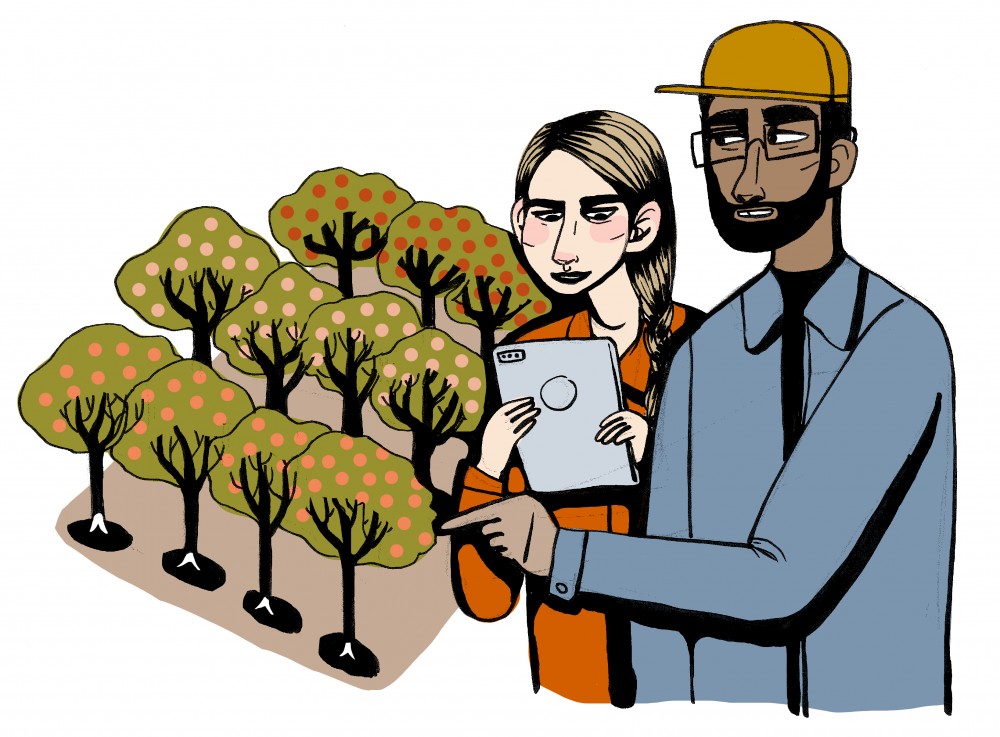A University of Minnesota startup, Farm Vision Technologies, was awarded a nearly $750,000 grant last month to fund their fruit mapping technology for farmers.
The technology aims to improve the accuracy of counting fruit in an orchard. If the company can do this, then farmers will more easily manage labor costs, marketing and shipping out their fruit, employees said.
“The primary benefit is being able to manage the crop better so that you can produce a more valuable yield,” said Patrick Plonski, CEO and co-founder of Farm Vision.
This grant, which was awarded by the National Science Foundation, will help them improve their research and development of fruit mapping technology, he said.
Plonski’s interest in agriculture began because his father was a pig farmer, he said.
“I see a lot of people graduating with fancy computer science degrees, and then they go work at Google, making more money for Google,” Plonski said. “I think helping out farmers feels like a tangible problem with real-world benefit, because everyone’s got to eat, and farming’s not easy.”
The agriculture industry loses significant profit due to inaccurate counts of their crop, he said. A mature, profitable orchard can make about $2,000 per acre in profit, he said.
“We’ve been talking to a lot of growers, and they estimate that the industry loses about $1,500 per acre because of inaccuracy in the year estimates,” Plonski said.
The technology consists of a scanner operated by the user, who takes it up and down the rows of the orchard, he said. The scanner takes the data, like the count of the crop, and transfers it to a cloud service program which processes it.
The company charges only for the area farmers use the scanner on. Right now, they have pilot projects going on with this method in Minnesota, Wisconsin, Washington and Florida.
“We plan to give them the hardware for very cheap and then charge them for use of the cloud service,” Plonski said. “The customers we’ve talked to have appreciated this model because it means there’s very low risk to trying it out.”
Farmers and growers are especially appreciative because they have tried other similar but less effective technologies before, Plonski said.
“The growers are kind of skeptical that [the technology] will actually work,” he said. “They haven’t been impressed with the results they’ve gotten.”
Part of the reason for this skepticism is some people underestimate the difficulty of making fruit mapping systems that are low-cost and work well in orchards, Plonski said.
This technology speeds up the counting process for farmers, said Jim Luby, the horticultural and agronomic adviser for the company.
“We could get a count if we spent enough time doing it,” he said.
The sensors can do the same thing in a fraction of the time.
“It’s really a whole new area of a type of product,” he said. “It certainly could have been conceptualized before, but it would have been way too expensive or impractical to try to market.”
Brian Dawn, the company’s chief technology officer, writes and maintains the code for the technology.
“The earlier that they can get these metrics, the better they can estimate and optimize all of their costs,” he said, which is what Farm Vision technology can do.
Farm Vision became commercial due to years of University and company research, Plonski said. The company will formally launch during the next growing season.
The company began as a research question in the University’s Robotic Sensor Networks Lab in 2014, co-founder Volkan Isler said in an email to the Minnesota Daily.
What began as a plan to build a robotic inspection system for apple packing lines turned into proof that farmers needed automotive systems for their harvests. That’s when they turned to mapping, he said in the email.
“As we developed the core science and technology, it became clear that the yield mapping component of this project is something farmers can benefit from immediately,” Isler said in the email.
Dawn said farmers are some of the hardest-working people he knows. Using this technology can help almost every aspect of their business, he said.
“I believe that one of the biggest issues facing humanity right now is the environment, and agriculture contributes to a large amount of CO2 emissions,” Dawn said. “The way I see it is that any way that we can improve efficiency for farmers will help fix the environment, hopefully.”
















